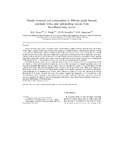Mantle structure and composition to 800-km depth beneath southern Africa and surrounding oceans from broadband body waves

View/
Date
2003Author
Simon, R.E.
Wright, C.
Kwadiba, M.T.O.
Kgaswane, E.M.
Publisher
Elsevier Science Ltd. www.elsevier.com/locate/lithosType
Published ArticleMetadata
Show full item recordAbstract
Average one-dimensional P and S wavespeed models from the surface to depths of 800 km were derived for the southern
African region using travel times and waveforms from earthquakes recorded at stations of the Kaapvaal and South African
seismic networks. The Herglotz–Wiechert method combined with ray tracing was used to derive a preliminary P wavespeed
model, followed by refinements using phase-weighted stacking and synthetic seismograms to yield the final model. Travel times
combined with ray tracing were used to derive the S wavespeed model, which was also refined using phase-weighted stacking
and synthetic seismograms. The presence of a high wavespeed upper mantle lid in the S model overlying a low wavespeed zone
(LWZ) around 210- to - 345-km depth that is not observed in the P wavespeed model was inferred.
The 410-km discontinuity shows similar characteristics to that in other continental regions, but occurs slightly deeper at 420
km. Depletion of iron and/or enrichment in aluminium relative to other regions are the preferred explanation, since the P
wavespeeds throughout the transition zone are slightly higher than average. The average S wavespeed structure beneath
southern Africa within and below the transition zone is similar to that of the IASP91 model. There is no evidence for
discontinuity at 520-km depth. The 660-km discontinuity also appears to be slightly deeper than average (668 km), although the
estimated thickness of the transition zone is 248 km, similar to the global average of 241 km. The small size of the 660-km
discontinuity for P waves, compared with many other regions, suggests that interpretation of the discontinuity as the
transformation of spinel to perovskite and magnesiowu¨ stite may require modification. Alternative explanations include the
presence of garnetite-rich material or ilmenite-forming phase transformations above the 660-km discontinuity, and the garnet–
perovskite transformation as the discontinuity.
